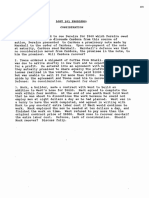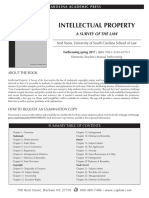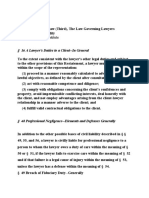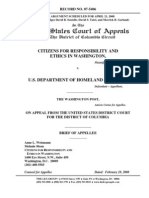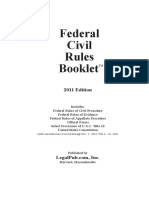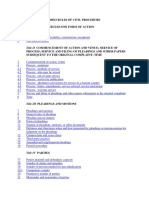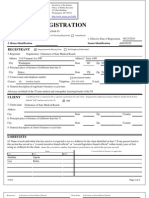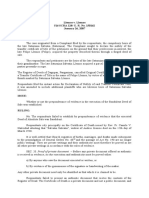Restatement 3rd
Restatement 3rd
Uploaded by
Livia Helena ThevenardCopyright:
Available Formats
Restatement 3rd
Restatement 3rd
Uploaded by
Livia Helena ThevenardOriginal Description:
Copyright
Available Formats
Share this document
Did you find this document useful?
Is this content inappropriate?
Copyright:
Available Formats
Restatement 3rd
Restatement 3rd
Uploaded by
Livia Helena ThevenardCopyright:
Available Formats
Restatement (Third) of Torts:
Physical Harm
1 Intent A person acts with the intent to produce a consequence if: (a) the person acts with the purpose of producing that consequence; or (b) the person acts knowing that the consequence is substantially certain to result.
Dual vs. Single intent: Single intent only needs the intent to contact. Limits of Substantial certainty cannot be an unkown/too large group of people for an extensive period of time. Example: owner of land constructing a building is substantially certain that some injuries will occur but doesnt face liability. 4 Physical Harm Physical harm means the physical impairment of the human body (bodily harm) or of real property or tangible personal property (property damage). Bodily harm includes physical injury, illness, disease, impairment of bodily function, and death.
Negligence Duty/Breach
10 Children (a) A child's conduct is negligent if it does not conform to that of a reasonably careful person of the same age, intelligence, and experience, except as provided in Subsection (b) or (c). (b) A child less than five years of age is incapable of negligence. (c) The special rule in Subsection (a) does not apply when the child is engaging in a dangerous activity that is characteristically undertaken by adults. 11 Disability (a) The conduct of an actor with a physical disability is negligent only if the conduct does not conform to that of a reasonably careful person with the same disability. (b) The conduct of an actor during a period of sudden incapacitation or loss of consciousness resulting from physical illness is negligent only if the sudden incapacitation or loss of consciousness was reasonably foreseeable to the actor. (c) An actor's mental or emotional disability is not considered in determining whether conduct is negligent, unless the actor is a child.
12 Knowledge and Skills If an actor has skills or knowledge that exceed those possessed by most others, these skills or knowledge are circumstances to be taken into account in determining whether the actor has behaved as a reasonably careful person. The fact that a person is below average in judgment, knowledge, or skills is generally ignored. 13 Custom (a) An actor's compliance with the custom of the community, or of others in like circumstances, is evidence that the actor's conduct is not negligent but does not preclude a finding of negligence. (b) An actor's departure from the custom of the community, or of others in like circumstances, in a way that increases risk is evidence of the actor's negligence but does not require a finding of negligence. 14 Statutory Violations as Negligence Per Se An actor is negligent if, without excuse, the actor violates a statute that is designed to protect against the type of accident the actor's conduct causes, and if the accident victim is within the class of persons the statute is designed to protect. But: 15 Excused Violations An actor's violation of a statute is excused and not negligence if: (a) the violation is reasonable in light of the actor's childhood, physical disability, or physical incapacitation; (b) the actor exercises reasonable care in attempting to comply with the statute; (c) the actor neither knows nor should know of the factual circumstances that render the statute applicable; (d) the actor's violation of the statute is due to the confusing way in which the requirements of the statute are presented to the public; or (e) the actor's compliance with the statute would involve a greater risk of physical harm to the actor or to others than noncompliance. 16 Statutory Compliance (a) An actor's compliance with a pertinent statute, while evidence of nonnegligence, does not preclude a finding that the actor is negligent under 3 for failing to adopt precautions in addition to those mandated by the statute. (b) If an actor's adoption of a precaution would require the actor to violate a statute, the actor cannot be found negligent for failing to adopt that precaution. 17 Res Ipsa Loquitur
The factfinder may infer that the defendant has been negligent when the accident causing the plaintiff's harm is a type of accident that ordinarily happens as a result of the negligence of a class of actors of which the defendant is the relevant member. Application - two other methods for articulating the test for res ipsa loquitur: A number of courts adopt a two-step inquiry: step one asks whether the accident is of a type that usually happens because of negligence, while step two asks whether the instrumentality inflicting the harm was under the exclusive control of the defendant. Another two-step formulation for res ipsa loquitur, accepted by some courts, is that res ipsa applies if the type of accident usually happens because of negligence, and if the negligence, when it occurs, is usually that of the defendant, rather than of some other party. 18 Negligent Failure to Warn (a) A defendant whose conduct creates a risk of physical or emotional harm can fail to exercise reasonable care by failing to warn of the danger if: (1) the defendant knows or has reason to know: (a) of that risk; and (b) that those encountering the risk will be unaware of it; and (2) a warning might be effective in reducing the risk of harm. (b) Even if the defendant adequately warns of the risk that the defendant's conduct creates, the defendant can fail to exercise reasonable care by failing to adopt further precautions to protect against the risk if it is foreseeable that despite the warning some risk of harm remains. 19 Conduct That Is Negligent Because of the Prospect of Improper Conduct by the Plaintiff or a Third Party The conduct of a defendant can lack reasonable care insofar as it foreseeably combines with or permits the improper conduct of the plaintiff or a third party.
Strict Liability
20 Abnormally Dangerous Activities (a) An actor who carries on an abnormally dangerous activity is subject to strict liability for physical harm resulting from the activity. (b) An activity is abnormally dangerous if: (1) the activity creates a foreseeable and highly significant risk of physical harm even when reasonable care is exercised by all actors; and (2) the activity is not one of common usage. 21 Intrusion by Livestock or Other Animals
An owner or possessor of livestock or other animals, except for dogs and cats, that intrude upon the land of another is subject to strict liability for physical harm caused by the intrusion. 22 Wild Animals (a) An owner or possessor of a wild animal is subject to strict liability for physical harm caused by the wild animal. (b) A wild animal is an animal that belongs to a category of animals that have not been generally domesticated and that are likely, unless restrained, to cause personal injury. 23 Abnormally Dangerous Animals An owner or possessor of an animal that the owner or possessor knows or has reason to know has dangerous tendencies abnormal for the animal's category is subject to strict liability for physical harm caused by the animal if the harm ensues from that dangerous tendency. 24 Scope of Strict Liability Strict liability under 20- 23 does not apply (a) if the person suffers physical or emotional harm as a result of making contact with or coming into proximity to the defendant's animal or abnormally dangerous activity for the purpose of securing some benefit from that contact or that proximity; or (b) if the defendant maintains ownership or possession of the animal or carries on the abnormally dangerous activity in pursuance of an obligation imposed by law.
Factual Cause
26 Factual Cause Tortious conduct must be a factual cause of harm for liability to be imposed. Conduct is a factual cause of harm when the harm would not have occurred absent the conduct. Tortious conduct may also be a factual cause of harm under 27. b. But-for standard for factual cause: an act is a factual cause of an outcome if, in the absence of the act, the outcome would not have occurred. An act can also be a factual cause in accelerating an outcome that otherwise would have occurred at a later time. The loss of the victim's remaining years of life caused by the electrocution provides the framework for determining the damages that would be recoverable in a wrongful-death action. Acceleration may occur for harms other than death as well. c. Tortious conduct need only be one of the factual causes of harm. The existence of other causes of the harm does not affect whether specified tortious conduct was a necessary condition for the harm to occur. k. Preemptive causes and duplicative factors. After a person suffers harm, another causal set may exist that, had the initial cause not existed, would have caused the same harm. Thus, this might occur when one hunter negligently fires a rifle, killing a hiker, and, shortly thereafter, another hunter negligently fires, and the
second shot would have been sufficient to cause the hiker's death, except that the death had already occurred. An act or omission cannot be a factual cause of an outcome that has already occurred. The first hunter's negligence is a cause of the hiker's death and preempts any causal role in the hiker's death of the second hunter's negligence. n. Lost opportunity or lost chance as harm. A number of courts have recognized a lost opportunity (or lost chance) for cure of a medical condition as a legally cognizable harm. Context: peculiar relationship between patients-doctors and a desire to increase care (just because a patient has a small chance of recovery should not allow the doctor to be negligent). 27 Multiple Sufficient Causes If multiple acts occur, each of which under 26 alone would have been a factual cause of the physical harm at the same time in the absence of the other act(s), each act is regarded as a factual cause of the harm. (from 26) j. Substantial factor: permits the factfinder decide that factual cause exists when there were multiple sufficient causes. 28 Burden of Proof The plaintiff has the burden to prove that the defendant's tortious conduct was a factual cause of the plaintiff's harm. (BUT) When the plaintiff sues all of multiple actors and proves that each engaged in tortious conduct that exposed the plaintiff to a risk of harm and that the tortious conduct of one or more of them caused the plaintiff's harm but the plaintiff cannot reasonably be expected to prove which actor or actors caused the harm, the burden of proof, including both production and persuasion, on factual causation is shifted to the defendants. i. Each defendant acted tortiously. Unless all of the actors who may have harmed the plaintiff acted tortiously, the rationale for invoking alternative liability is absent. Courts continue, without exception, to turn away plaintiffs who are unable to establish this element. Example: Two hunters negligently shoot in the direction of P, and one of the bullets hit him. P doesnt know whose bullet that is, but can sue both.
Scope of Liability (Proximate Cause)
29 Limitations on Liability for Tortious Conduct An actor's liability is limited to those harms that result from the risks that made the actor's conduct tortious. Risk standard = Harm different from the harms risked by the tortious conduct. Central to the limitation on liability of this Section is the idea that an actor should be held liable only for harm that was among the potential harmsthe risksthat made the actor's conduct tortious. The term scope of liability is employed to distinguish those harms that fall within this standard and, thus, for which the defendant is subject to liability and, on the other hand, those harms for which the defendant is not liable. Similar test: Foreseeability more specific then the foreseeability for breach.
Manner of harm ( Type of harm). Courts commonly state that the manner in which the harm occurs is irrelevant to scope of liability so long as the harm is foreseeable or within the risk standard. 30 Risk of Harm Not Generally Increased by Tortious Conduct An actor is not liable for harm when the tortious aspect of the actor's conduct was of a type that does not generally increase the risk of that harm. Illustrations: Gordie is driving 35 miles per hour on a city street with a speed limit of 25 miles per hour with Nathan as his passenger. Without warning, a tree crashes on Gordie's car, injuring Nathan. Gordie's speeding is a factual cause of Nathan's harm because, if Gordie had not been traveling at 35 miles per hour, he would not have arrived at the location where the tree fell at the precise time that it fell. Gordie is not liable to Nathan because Gordie's speeding did not increase the risk of the type of harm suffered by Nathan. The speeding merely put Gordie at the place and time at which the tree fell. This is true even if the type of harm suffered by Nathan might be found to be one of the risks arising from speeding in an automobile. Wayne is negligently driving an automobile at excessive speed. Meg is driving in the opposing lane and negligently crosses the center line of the highway, sideswiping Wayne's car, causing damage to the car but not to Wayne. As a result of the contact, Wayne loses control of his car, and it skids off the highway where the passenger side collides with a parked car, owned by David. Wayne is thrown from his car in the collision and suffers personal injury. In Wayne's suit against Meg, the evidence reveals that Wayne's excessive speed did not increase the risk of the collision with Meg, but the excessive speed did increase the risk that Wayne would lose control of his vehicle after the collision. Based on this evidence, Wayne's contributory negligence in speeding would not reduce his recovery from Meg for the sideswipe harm to Wayne's vehicle, but the speeding would be the basis for reducing his recovery from Meg for his personal injuries. If David sued Wayne and Meg, both Wayne's and Meg's negligence would subject them to liability to David for the damage to his car. The same percentages of comparative responsibility determined by the factfinder for Wayne's personal injury would be applicable to apportioning liability between Wayne and Meg for David's harm. 31 Preexisting Conditions and Unforeseeable Harm When an actor's tortious conduct causes harm to a person that, because of a preexisting physical or mental condition or other characteristics of the person, is of a greater magnitude or different type than might reasonably be expected, the actor is nevertheless subject to liability for all such harm to the person. Known colloquially as the thin-skull or eggshell plaintiff rule, and described often as the defe ndant takes the victim as found. Even in those cases in which the harm may be found to be beyond the risk standard, the thin-skull rule contained in this Section applies and makes the tortfeasor subject to liability for the harm. 32 Rescuers Notwithstanding 29 or 34, if an actor's tortious conduct imperils another or the property of another, the scope of the actor's liability includes any harm to a person resulting from that person's efforts to aid or to protect the imperiled person or property, so long as the harm arises from a risk that inheres in the effort to provide aid. An actor whose tortious conduct puts the actor or another at risk, is subject to liability to a third person who is injured while attempting to come to the aid of the actor or of the other imperiled person. This is also applicable to a rescuer of imperiled property, whether that property is owned by another or by the rescuer.
The actor is subject to liability regardless of whether the rescuer might be thought foreseeable or whether harm to the rescuer might be thought within the risk standard. Thus, while harm to a rescuer might be found unforeseeable or the rescuer's decision to aid another might be characterized as a superseding cause, scope of liability does not prevent a rescuer from recovering for injuries suffered as a result of the rescue. 33 Scope of Liability for Intentional and Reckless Tortfeasors (a) An actor who intentionally causes harm is subject to liability for that harm even if it was unlikely to occur. (b) An actor who intentionally or recklessly causes harm is subject to liability for a broader range of harms than the harms for which that actor would be liable if only acting negligently. In general, the important factors in determining the scope of liability are the moral culpability of the actor, as reflected in the reasons for and intent in committing the tortious acts, the seriousness of harm intended and threatened by those acts, and the degree to which the actor's conduct deviated from appropriate care. (c) Notwithstanding Subsections (a) and (b), an actor who intentionally or recklessly causes harm is not subject to liability for harm the risk of which was not increased by the actor's intentional or reckless conduct. 34 Intervening Acts and Superseding Causes When a force of nature or an independent act is also a factual cause of harm, an actor's liability is limited to those harms that result from the risks that made the actor's conduct tortious. Intervening forces (or acts) consist of acts, omissions, or other forces that occur after the tortious conduct of the actor and that are other than the background causes that ordinarily exist. A superseding cause is an intervening force or act that is deemed sufficient to prevent liability for an actor whose tortious conduct was a factual cause of harm. The act may be tortious or entirely innocent. 35 Enhanced Harm Due to Efforts to Render Medical or Other Aid An actor whose tortious conduct is a factual cause of harm to another is subject to liability for any enhanced harm the other suffers due to the efforts of third persons to render aid reasonably required by the other's injury, so long as the enhanced harm arises from a risk that inheres in the effort to render aid.
Affirmative Duties
37 No Duty of Care with Respect to Risks Not Created by Actor An actor whose conduct has not created a risk of physical or emotional harm to another has no duty of care to the other unless a court determines that one of the affirmative duties provided in 38- 44 is applicable. There are several exceptions to this Section's no-duty rule. They are set forth in the remainder of this Chapter. These exceptions impose a duty to take action to prevent or ameliorate the risk of harm created by others. When one or more of the exceptions is applicable, breach of duty, factual causation, and scope of liability must also be addressed before determining the actor's liability.
Misfeasance and nonfeasance = concepts used to explain the distinction between affirmatively creating risk and merely failing to prevent harm. However, this distinction can be misleading. (RT2nd) 40 Duty Based on Special Relationship with Another (a) An actor in a special relationship with another owes the other a duty of reasonable care with regard to risks that arise within the scope of the relationship. (b) Special relationships giving rise to the duty provided in Subsection (a) include: (1) a common carrier with its passengers, (2) an innkeeper with its guests, (3) a business or other possessor of land that holds its premises open to the public with those who are lawfully on the premises, (4) an employer with its employees who, while at work, are: (a) in imminent danger; or (b) injured or ill and thereby rendered helpless, (5) a school with its students, (6) a landlord with its tenants, and (7) a custodian with those in its custody, if: (a) the custodian is required by law to take custody or voluntarily takes custody of the other; and (b) the custodian has a superior ability to protect the other. Scope of the duty. The duty imposed in this Section applies to dangers that arise within the confines of the relationship and does not extend to other risks. Generally, the relationships in this Section are bounded by geography and time. Thus, this Section imposes no affirmative duty on a common carrier to a person who left the vehicle and is no longer a passenger. Similarly, an innkeeper is ordinarily under no duty to a guest who is injured or endangered while off the premises. Of course, if the relationship is extended such as by a cruise ship conducting an onshore touran affirmative duty pursuant to this Section might be appropriate. 41 Duty to Third Parties Based on Special Relationship with Person Posing Risks (a) An actor in a special relationship with another owes a duty of reasonable care to third parties with regard to risks posed by the other that arise within the scope of the relationship. (b) Special relationships giving rise to the duty provided in Subsection (a) include: (1) a parent with dependent children, (2) a custodian with those in its custody,
(3) an employer with employees when the employment facilitates the employee's causing harm to third parties, and (4) a mental-health professional with patients. It is often said that parents are not vicariously liable for the torts of their children. This Section is not contrary to that proposition. Before liability may be imposed on parents, they must act negligently with regard to risks posed by their minor children. 42 Duty Based on Undertaking An actor who undertakes to render services to another and who knows or should know that the services will reduce the risk of physical harm to the other has a duty of reasonable care to the other in conducting the undertaking if: (a) the failure to exercise such care increases the risk of harm beyond that which existed without the undertaking, or (b) the person to whom the services are rendered or another relies on the actor's exercising reasonable care in the undertaking. Court determinations of no duty based on special problems of principle or policy . Even though an affirmative duty might exist pursuant to this Section, a court may decide, based on special problems of principle or policy, that no duty or a duty other than reasonable care exists.
Liability for Emotional Harm
Pure or stand-alone emotional harm. 46 Intentional (or Reckless) Infliction of Emotional Harm An actor who by extreme and outrageous conduct intentionally or recklessly causes severe emotional harm to another is subject to liability for that emotional harm and, if the emotional harm causes bodily harm, also for the bodily harm. This Section applies to emotional harm to a person that is not itself caused by bodily harm to that person. Illustration: Jones intentionally and repeatedly humiliates Smith for the purpose of causing her to have a miscarriage and does cause her to miscarry. Jones may be liable under the rule stated in this Section for the emotional harm and the resulting bodily harm. Jones may also be liable for intentionally causing bodily harm. Whether an actor's conduct is extreme and outrageous depends on the facts of each case, including the relationship of the parties, whether the actor abused a position of authority over the other person, whether the other person was especially vulnerable and the actor knew of the vulnerability, the motivation of the actor, and whether the conduct was repeated or prolonged.
47 Negligent Conduct Directly Inflicting Emotional Harm on Another An actor whose negligent conduct causes serious emotional harm to another is subject to liability to the other if the conduct: (a) places the other in danger of immediate bodily harm and the emotional harm results from the danger; or (b) occurs in the course of specified categories of activities, undertakings, or relationships in which negligent conduct is especially likely to cause serious emotional harm. 48 Negligent Infliction of Emotional Harm Resulting from Bodily Harm to a Third Person An actor who negligently causes sudden serious bodily injury to a third person is subject to liability for serious emotional harm caused thereby to a person who: (a) perceives the event contemporaneously, and (b) is a close family member of the person suffering the bodily injury. In Dillon, the court allowed a mother who witnessed the defendant's car hit her son to recover for her own emotional harm even though the defendant's car never touched her and even though she herself was never in danger of being hit. The plaintiff's emotional harm was due solely to witnessing the accident that harmed her son, a third party.
Special cases of DUTY Duty of Land Possessors
51 General Duty of Land Possessors Subject to 52, a land possessor owes a duty of reasonable care to entrants on the land with regard to: (a) conduct by the land possessor that creates risks to entrants on the land; (b) artificial conditions on the land that pose risks to entrants on the land; (c) natural conditions on the land that pose risks to entrants on the land; and (d) other risks to entrants on the land when any of the affirmative duties provided in Chapter 7 is applicable. 52 Duty of Land Possessors to Flagrant Trespassers (a) The only duty a land possessor owes to flagrant trespassers is the duty not to act in an intentional, willful, or wanton manner to cause physical harm. (b) Notwithstanding Subsection (a), a land possessor has a duty to flagrant trespassers to exercise reasonable care if the trespasser reasonably appears to be imperiled and
(1) helpless; or (2) unable to protect him or herself. 53 Duty of Lessors Except as provided in 52, a lessor owes to the lessee and all other entrants on the leased premises the following duties: (a) a duty of reasonable care under 51 for those portions of the leased premises over which the lessor retains control; (b) a duty of reasonable care under 7 for any risks that are created by the lessor in the condition of the leased premises; (c) a duty to disclose to the lessee any dangerous condition that satisfies all of the following: (1) it poses a risk to entrants on the leased premises; (2) it exists on the leased premises when the lessee takes possession; (3) it is latent and unknown to the lessee; and (4) it is known or should be known to the lessor; (d) a duty of reasonable care for any dangerous condition on the leased premises at the time the lessee takes possession if: (1) the lease is for a purpose that includes admission of the public; and (2) the lessor has reason to believe that the lessee will admit persons onto the leased premises without rectifying the dangerous condition; (e) a duty of reasonable care: (1) for any contractual undertaking; or (2) for any voluntary undertaking, under 42- 43, with regard to the condition of the leased premises; (f) a duty based on an applicable statute imposing obligations on lessors with regard to the condition of leased premises, unless the court finds that recognition of a tort duty is inconsistent with the statute; (g) a duty of reasonable care to comply with an applicable implied warranty of habitability; and (h) a duty of reasonable care to lessees under 40, Comment m, as well as any other affirmative duties that may apply. See Chapter 7.
You might also like
- Complaint Against Attorney Kyle Fleming, Attorney Andy Bolton, and Attorney Michael Gayoso 07152015No ratings yetComplaint Against Attorney Kyle Fleming, Attorney Andy Bolton, and Attorney Michael Gayoso 0715201547 pages
- Santa Barbara Co. Public Defender's Office Petition For Habeas Corpus + Exhibits100% (2)Santa Barbara Co. Public Defender's Office Petition For Habeas Corpus + Exhibits143 pages
- Tutorial 2: Auditors Legal Liabilities MCQNo ratings yetTutorial 2: Auditors Legal Liabilities MCQ7 pages
- Restatement 3rd - Lawyers' Civil LiabilityNo ratings yetRestatement 3rd - Lawyers' Civil Liability7 pages
- Federal Rules of Civil Procedure 2008 PDFNo ratings yetFederal Rules of Civil Procedure 2008 PDF2 pages
- LSE Key Concepts: Criminal Law W I C B ? M R - I: Martin v. State VariationsNo ratings yetLSE Key Concepts: Criminal Law W I C B ? M R - I: Martin v. State Variations7 pages
- The Civil Jury Trial and The Law-Fact DistinctionNo ratings yetThe Civil Jury Trial and The Law-Fact Distinction73 pages
- Notice and Demand For Impeachment 03192012No ratings yetNotice and Demand For Impeachment 0319201226 pages
- 3l Feb 2 2017 The Bar Exam With CF and Il Slides UpdatedNo ratings yet3l Feb 2 2017 The Bar Exam With CF and Il Slides Updated75 pages
- Instant Download (Ebook PDF) Property Law: Rules Policies and Practices (Connected Casebook) (Aspen Casebook) 6th Edition PDF All Chapters100% (5)Instant Download (Ebook PDF) Property Law: Rules Policies and Practices (Connected Casebook) (Aspen Casebook) 6th Edition PDF All Chapters41 pages
- Bench Memorandum: Reciprocal Discovery in Criminal Cases100% (2)Bench Memorandum: Reciprocal Discovery in Criminal Cases33 pages
- Restatement of Torts 2d: 552 Information Negligently Supplied For The Guidance of OthersNo ratings yetRestatement of Torts 2d: 552 Information Negligently Supplied For The Guidance of Others1 page
- Civilprocedure (With 20 General Civil Forms Oh)No ratings yetCivilprocedure (With 20 General Civil Forms Oh)434 pages
- Registration by Federation of State Medical Boards To Lobby For Federation of State Medical Boards (300307117)No ratings yetRegistration by Federation of State Medical Boards To Lobby For Federation of State Medical Boards (300307117)2 pages
- Robert Eugene ROGERS, Appellant, v. Officer Kevin POWELL Officer Jeffrey Stine, A/k/a Stiney Officer Timothy Eiler Officer James Edwards, AppelleesNo ratings yetRobert Eugene ROGERS, Appellant, v. Officer Kevin POWELL Officer Jeffrey Stine, A/k/a Stiney Officer Timothy Eiler Officer James Edwards, Appellees15 pages
- Property Law - Dukeminier CH 1A and 1B PPNo ratings yetProperty Law - Dukeminier CH 1A and 1B PP21 pages
- Understanding Criminal Procedure: Volume 1: InvestigationNo ratings yetUnderstanding Criminal Procedure: Volume 1: Investigation518 pages
- Constitutional Criminal Procedure Outline Jared OlenNo ratings yetConstitutional Criminal Procedure Outline Jared Olen43 pages
- Business Law Syllabus - UNIVERSITY OF MADRAS - B.COM CA 201833% (3)Business Law Syllabus - UNIVERSITY OF MADRAS - B.COM CA 20181 page
- Mindmap - Regulating The Triangular Employment Relationship Through Labour Law and Social Dialogue?No ratings yetMindmap - Regulating The Triangular Employment Relationship Through Labour Law and Social Dialogue?1 page
- Detailed Explanation To Culpable Homicide and Murder Section 299 and 300 IPC Class 3No ratings yetDetailed Explanation To Culpable Homicide and Murder Section 299 and 300 IPC Class 335 pages
- SONNY LO v. KJS ECO-FORMWORK SYSTEM (OBLI)No ratings yetSONNY LO v. KJS ECO-FORMWORK SYSTEM (OBLI)5 pages
- 26) Heirs of Honrales vs. Honrales (629 SCRA 423, 2010)No ratings yet26) Heirs of Honrales vs. Honrales (629 SCRA 423, 2010)2 pages
- Panay Railways, Inc. vs. HEVA Management and Development Corporation, 664 SCRA 1, January 25, 2012No ratings yetPanay Railways, Inc. vs. HEVA Management and Development Corporation, 664 SCRA 1, January 25, 201210 pages
- SILVERIO V REPUBLIC - G.R. No. 174689 - GAYARES PDFNo ratings yetSILVERIO V REPUBLIC - G.R. No. 174689 - GAYARES PDF2 pages
- Surgery or Savagery, Medical Negligence in India by Abhishek DixitNo ratings yetSurgery or Savagery, Medical Negligence in India by Abhishek Dixit9 pages
- People vs. Alfredo Taruc and Antonio Efe, Jr. G. R. No. L-69337-38 March 8, 1989 FactsNo ratings yetPeople vs. Alfredo Taruc and Antonio Efe, Jr. G. R. No. L-69337-38 March 8, 1989 Facts1 page
- Form No: HCJD/C-121 Order Sheet in The Lahore High Court, Lahore Judicial Department W.P No.25955-2012. VsNo ratings yetForm No: HCJD/C-121 Order Sheet in The Lahore High Court, Lahore Judicial Department W.P No.25955-2012. Vs8 pages
- The First Handbook For Refugees Rights in Burmese Language Published - EngageMedia"No ratings yetThe First Handbook For Refugees Rights in Burmese Language Published - EngageMedia"2 pages
- Syllabus - Philosophy of Law (1S AY 2023-24) FINALNo ratings yetSyllabus - Philosophy of Law (1S AY 2023-24) FINAL5 pages
- Crimes Against Personal Liberty and SecurityNo ratings yetCrimes Against Personal Liberty and Security23 pages
- Complaint Against Attorney Kyle Fleming, Attorney Andy Bolton, and Attorney Michael Gayoso 07152015Complaint Against Attorney Kyle Fleming, Attorney Andy Bolton, and Attorney Michael Gayoso 07152015
- Santa Barbara Co. Public Defender's Office Petition For Habeas Corpus + ExhibitsSanta Barbara Co. Public Defender's Office Petition For Habeas Corpus + Exhibits
- LSE Key Concepts: Criminal Law W I C B ? M R - I: Martin v. State VariationsLSE Key Concepts: Criminal Law W I C B ? M R - I: Martin v. State Variations
- 3l Feb 2 2017 The Bar Exam With CF and Il Slides Updated3l Feb 2 2017 The Bar Exam With CF and Il Slides Updated
- Instant Download (Ebook PDF) Property Law: Rules Policies and Practices (Connected Casebook) (Aspen Casebook) 6th Edition PDF All ChaptersInstant Download (Ebook PDF) Property Law: Rules Policies and Practices (Connected Casebook) (Aspen Casebook) 6th Edition PDF All Chapters
- Bench Memorandum: Reciprocal Discovery in Criminal CasesBench Memorandum: Reciprocal Discovery in Criminal Cases
- Restatement of Torts 2d: 552 Information Negligently Supplied For The Guidance of OthersRestatement of Torts 2d: 552 Information Negligently Supplied For The Guidance of Others
- Registration by Federation of State Medical Boards To Lobby For Federation of State Medical Boards (300307117)Registration by Federation of State Medical Boards To Lobby For Federation of State Medical Boards (300307117)
- Robert Eugene ROGERS, Appellant, v. Officer Kevin POWELL Officer Jeffrey Stine, A/k/a Stiney Officer Timothy Eiler Officer James Edwards, AppelleesRobert Eugene ROGERS, Appellant, v. Officer Kevin POWELL Officer Jeffrey Stine, A/k/a Stiney Officer Timothy Eiler Officer James Edwards, Appellees
- Understanding Criminal Procedure: Volume 1: InvestigationUnderstanding Criminal Procedure: Volume 1: Investigation
- Constitutional Criminal Procedure Outline Jared OlenConstitutional Criminal Procedure Outline Jared Olen
- Business Law Syllabus - UNIVERSITY OF MADRAS - B.COM CA 2018Business Law Syllabus - UNIVERSITY OF MADRAS - B.COM CA 2018
- Mindmap - Regulating The Triangular Employment Relationship Through Labour Law and Social Dialogue?Mindmap - Regulating The Triangular Employment Relationship Through Labour Law and Social Dialogue?
- Detailed Explanation To Culpable Homicide and Murder Section 299 and 300 IPC Class 3Detailed Explanation To Culpable Homicide and Murder Section 299 and 300 IPC Class 3
- 26) Heirs of Honrales vs. Honrales (629 SCRA 423, 2010)26) Heirs of Honrales vs. Honrales (629 SCRA 423, 2010)
- Panay Railways, Inc. vs. HEVA Management and Development Corporation, 664 SCRA 1, January 25, 2012Panay Railways, Inc. vs. HEVA Management and Development Corporation, 664 SCRA 1, January 25, 2012
- SILVERIO V REPUBLIC - G.R. No. 174689 - GAYARES PDFSILVERIO V REPUBLIC - G.R. No. 174689 - GAYARES PDF
- Surgery or Savagery, Medical Negligence in India by Abhishek DixitSurgery or Savagery, Medical Negligence in India by Abhishek Dixit
- People vs. Alfredo Taruc and Antonio Efe, Jr. G. R. No. L-69337-38 March 8, 1989 FactsPeople vs. Alfredo Taruc and Antonio Efe, Jr. G. R. No. L-69337-38 March 8, 1989 Facts
- Form No: HCJD/C-121 Order Sheet in The Lahore High Court, Lahore Judicial Department W.P No.25955-2012. VsForm No: HCJD/C-121 Order Sheet in The Lahore High Court, Lahore Judicial Department W.P No.25955-2012. Vs
- The First Handbook For Refugees Rights in Burmese Language Published - EngageMedia"The First Handbook For Refugees Rights in Burmese Language Published - EngageMedia"
- Syllabus - Philosophy of Law (1S AY 2023-24) FINALSyllabus - Philosophy of Law (1S AY 2023-24) FINAL






